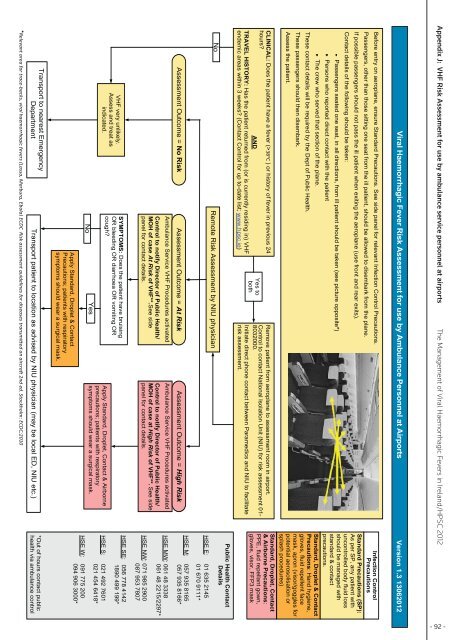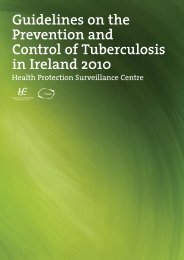The Management of Viral Haemorrhagic Fevers in Ireland - Health ...
The Management of Viral Haemorrhagic Fevers in Ireland - Health ...
The Management of Viral Haemorrhagic Fevers in Ireland - Health ...
Create successful ePaper yourself
Turn your PDF publications into a flip-book with our unique Google optimized e-Paper software.
Appendix J: VHF Risk Assessment for use by ambulance service personnel at airports <strong>The</strong> <strong>Management</strong> <strong>of</strong> <strong>Viral</strong> <strong>Haemorrhagic</strong> <strong>Fevers</strong> <strong>in</strong> <strong>Ireland</strong>/HPSC 2012<strong>Viral</strong> <strong>Haemorrhagic</strong> Fever Risk Assessment for use by Ambulance Personnel at Airports Version 1.3 13062012Before entry on aeroplane, ensure Standard Precautions. See side panel for relevant Infection Control Precautions.Passengers, other than those sitt<strong>in</strong>g one seat from the ill patient, should be allowed to disembark from the plane.If possible passengers should not pass the ill patient when exit<strong>in</strong>g the aeroplane (use front and rear exits).Contact details <strong>of</strong> the follow<strong>in</strong>g should be taken:Passengers seated one seat, <strong>in</strong> all directions, from ill patient should be taken (see picture opposite*)Persons who reported direct contact with the patient<strong>The</strong> crew who served that section <strong>of</strong> the plane.<strong>The</strong>se contact details will be required by the Dept <strong>of</strong> Public <strong>Health</strong>.<strong>The</strong>se passengers should then disembark.Assess the patient.CLINICAL: Does the patient have a fever (>38 o C ) or history <strong>of</strong> fever <strong>in</strong> previous 24hours?ANDTRAVEL HISTORY: Has the patient returned from (or is currently resid<strong>in</strong>g <strong>in</strong>) VHFendemic areas with<strong>in</strong> 3 weeks? (Contact Control for up to-date list; www.hpsc.ie)Yes tobothRemove patient from aeroplane to assessment room <strong>in</strong> airport.Control to contact National Isolation Unit (NIU) for risk assessment 01-8032000.Initiate direct phone contact between Paramedics and NIU to facilitaterisk assessment.Infection ControlPrecautionsStandard Precautions (SP):As per SP, any patient withuncontrolled body fluid lossshould be managed withstandard & contactprecautions.Standard, Droplet & ContactPrecautions: Hand hygiene,gloves, fluid repellent facemask, apron (visor/goggles forpotential aerosolisation orsplash procedures)Standard, Droplet, Contact& Airborne Precautions:PPE, fluid repellant gown,gloves, visor, FFP3 maskNoRemote Risk Assessment by NIU physicianPublic <strong>Health</strong> ContactDetailsHSE E: 01 635 214501 670 9111*Assessment Outcome = No RiskAssessment Outcome = At RiskAssessment Outcome = High RiskHSE M: 057 935 8165057 935 8166*Ambulance Service VHF Procedures activatedControl to notify Director <strong>of</strong> Public <strong>Health</strong>/MOH <strong>of</strong> case At Risk <strong>of</strong> VHF**. See sidepanel for contact details.Ambulance Service VHF Procedures activatedControl to notify Director <strong>of</strong> Public <strong>Health</strong>/MOH <strong>of</strong> case at High Risk <strong>of</strong> VHF**. See sidepanel for contact details.HSE MW: 061 48 3338061 48 2215/2297*HSE NW: NE: 046 071 907 985 6412 2900087 086 953 606 7807 2537VHF very unlikely.Assess and treat as<strong>in</strong>dicated.SYMPTOMS: Does the patient have bruis<strong>in</strong>gOR bleed<strong>in</strong>g OR diarrhoea OR vomit<strong>in</strong>g ORcough?NoYesApply Standard, Droplet & ContactPrecautions; patients with respiratorysymptoms should wear a surgical mask.Apply Standard, Droplet, Contact & Airborneprecautions; patients with respiratorysymptoms should wear a surgical mask.HSE SE: 056 778 41421890 499 199*HSE S: 021 492 7601021 454 6418*HSE W: 091 775 200094 906 3000*Transport to nearest EmergencyDepartmentTransport patient to location as advised by NIU physician (may be local ED, NIU etc.)*Out <strong>of</strong> hours contact publichealth via ambulance control*Relevant area for trace-backs, viral haemorrhagic fevers (Lassa, Marburg, Ebola) ECDC Risk assessment guidel<strong>in</strong>es for diseases transmitted on aircraft 2nd ed. Stockholm: ECDC;2010**Requirement to contact Director <strong>of</strong> Public <strong>Health</strong>/Medical Officer <strong>of</strong> <strong>Health</strong> under Infectious Disease Aircraft Regulations.- 92 -
















